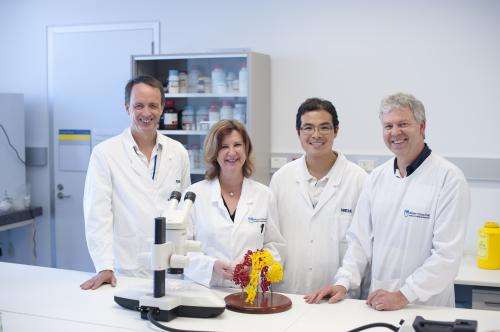First image of insulin 'docking' could lead to better diabetes treatments

A landmark discovery about how insulin docks on cells could help in the development of improved types of insulin for treating both type 1 and type 2 diabetes.
For the first time, researchers have captured the intricate way in which insulin uses the insulin receptor to bind to the surface of cells. This binding is necessary for the cells to take up sugar from the blood as energy.
The research team was led by the Walter and Eliza Hall Institute and used the Australian Synchrotron in Melbourne, Australia. The study was published today in the journal Nature.
For more than 20 years scientists have been trying to solve the mystery of how insulin binds to the insulin receptor. A research team led by Associate Professor Mike Lawrence, Professor Colin Ward and Dr John Menting have now found the answer.
Associate Professor Lawrence from the institute's Structural Biology division said the team was excited to reveal for the first time a three-dimensional view of insulin bound to its receptor. "Understanding how insulin interacts with the insulin receptor is fundamental to the development of novel insulins for the treatment of diabetes," Associate Professor Lawrence said. "Until now we have not been able to see how these molecules interact with cells. We can now exploit this knowledge to design new insulin medications with improved properties, which is very exciting."
The Australian Synchrotron's MX2 microcrystallography beamline was critical to the project's success. "If we did not have this fantastic facility in Australia and their staff available to help us, we would simply not have been able to complete this project," Associate Professor Lawrence said.
Associate Professor Lawrence assembled an international team of project collaborators, including researchers from Case Western Reserve University, the University of Chicago, the University of York and the Institute of Organic Chemistry and Biochemistry in Prague. "Collaborations in this field are essential," he said. "No one laboratory has all the resources, expertise and experience to take on a project as difficult as this one."
"We have now found that the insulin hormone engages its receptor in a very unusual way," Associate Professor Lawrence said. "Both insulin and its receptor undergo rearrangement as they interact – a piece of insulin folds out and key pieces within the receptor move to engage the insulin hormone. You might call it a 'molecular handshake'."
Australia is facing an increasing epidemic of type 2 diabetes. There are now approximately one million Australians living with diabetes and around 100,000 new diagnoses each year.
"Insulin controls when and how glucose is used in the human body," Associate Professor Lawrence said. "The insulin receptor is a large protein on the surface of cells to which the hormone insulin binds. The generation of new types of insulin have been limited by our inability to see how insulin docks into its receptor in the body.
"Insulin is a key treatment for diabetics, but there are many ways that its properties could potentially be improved," Associate Professor Lawrence said. "This discovery could conceivably lead to new types of insulin that could be given in ways other than injection, or an insulin that has improved properties or longer activity so that it doesn't need to be taken as often. It may also have ramifications for diabetes treatment in developing nations, by creating insulin that is more stable and less likely to degrade when not kept cold, an angle being pursued by our collaborators. Our findings are a new platform for developing these kinds of medications."
















